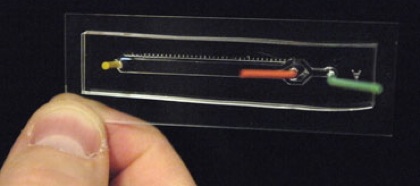 MIT researchers have built a tiny microhabitat to study the food chain of marine microbes. The microbial ecosystem is about the size of a piece of chewing gum, or microscope slide.
MIT researchers have built a tiny microhabitat to study the food chain of marine microbes. The microbial ecosystem is about the size of a piece of chewing gum, or microscope slide.From the MIT News Office:
The MIT study is one of the first detailed explorations of how sea creatures so small -- 500,000 can fit on the head of a pin -- find food in an ocean-size environment...
Depending on the organism being studied, nutrients or prey are injected with a syringe-based pump into the device's microfluidic channel, which is 45 mm long, 3 mm wide and 50 micrometers deep. "While relying on different swimming strategies, all three organisms exhibited behaviors which permitted efficient and rapid exploitation of resource patches," (professor Roman) Stocker said. It took bacteria less than 30 seconds, for example, to congregate within a patch of organic nutrients.
This new laboratory tool creates a microhabitat where tiny sea creatures live, swim, assimilate chemicals and eat each other. It provides the first methodological, sub-millimeter scale examination of a food web that includes single-celled phytoplankton, bacteria and protozoan predators in action.

No comments:
Post a Comment